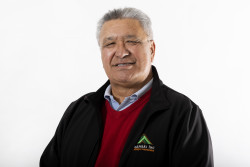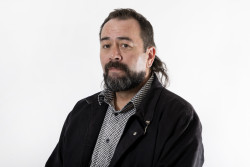Iwi are represented on key Council committees and are consulted closely in resource consenting, planning and other processes. The Council also helps to empower iwi to monitor freshwater quality.
As part of the region's Treaty of Waitangi settlements three iwi representatives are appointed to each of the Council’s two main standing committees, the Policy and Planning Committee and the Operations and Regulatory Committee.
All eight iwi in the region are involved in the selection process with the appointees chosen to ensure each committee has connections from the three Taranaki waka — Aotea, Kurahaupō and Tokomaru.
The appointees act in the interests of the committee they are part of, while bringing an iwi perspective to the table.
Iwi representatives for 2022-2025 are as follows:
| Policy & Planning Committee | Operations & Regulatory Committee |
|
Peter Moeahu (above) Emily Bailey Mitchell Ritai |
Dion Luke (above) Ānaru White Richard Buttimore |
Mātauranga Māori
The Council is obliged to incorporate mātauranga Māori (traditional Māori knowledge) alongside western science into freshwater planning and monitoring. An essential first step is have a good understanding of mātauranga Māori regarding freshwater in the Taranaki region.
To provide a basis for consultation, discussion and debate, this draft internal report canvasses some of the issues involved and considers the challenges, responses and successes that have occurred in other regions.
The Council is continuing this investigation and will seek additional input from the local iwi and hapū as the work progresses.
Incorporating Mātauranga Māori into the Monitoring of Freshwater [PDF, 1.3 MB]
Water-quality monitoring
Taranaki Regional Council is empowering iwi and hapu in the region to monitor the health of waterways. Here is a video of the work that Ngaa Rauru Kiitahu are doing in this space.
Empowering Ngaa Rauru Kiitahi
Resource consents & planning
The Council strongly encourages resource consent applicants to ensure iwi and/or hapū are consulted where necessary, and that actual or potential effects on them are clearly spelled out.
Any implications for iwi or hapū are a major consideration in deciding whether an application should be publicly notified. If necessary, the Council will provide information and technical assistance on the consents or the consenting process and will arrange and facilitate meetings, including meetings on marae if appropriate. Necessary steps will be taken to avoid offence to tikanga Māori or publicly disclose the location of wāhi tapu.
If appropriate, the Council also considers involving iwi or hapū in the design and operation of consent compliance monitoring programmes. Iwi and hapū have also had input in investigations and prosecutions.
Similarly, the Council strives to give iwi and hapu opportunities for full and genuine involvement in its own planning processes, by providing full and sufficient information and allowing time for it to be digested and responded to. The Council also takes Iwi Management Plans into account in its own regional plans and Regional Policy Statement.
Other consultation & collaboration
The Council and its officers meet regularly with iwi and hapū on a range of issues of mutual interest, and the Council contracts with Māori for delivery of specific services including advice, expertise, information, research projects and training.
The Council also provides resources including technical assistance and advice.
Get in touch
Talk to our Iwi Communications Officer. Call 0800 736 222 or email iwicommunications@trc.govt.nz.
Taranaki Tāngata Tū Tahi
Taranaki as One

The Taranaki Regional Council boardroom features this artwork, called Taranaki Tāngata Tū Tahi - Taranaki as One
Taranaki Tāngata refers to the people, the mountain, the land – and the region as a whole. Tū Tahi refers to standing together as one people to achieve a united goal for the benefit of our region.
Taranaki Tāngata Tū Tahi is a statement that recognises the roles and responsibilities shared by all people in Taranaki to ensure sustainable management, development and protection of the region’s natural resources for future generations.
The artwork, by Rangi Kipa, gives visual expression to Taranaki Tāngata Tū Tahi. The central image is the mountain, or maunga, the wellspring of the Taranaki environment and all that is within it. Standing together with the mountain are the three waka, Aotea, Kurahaupō and Tokomaru. Sub-symbols and colouring encapsulate key elements of the environment including water, forest, flax, fish and birds. Many of the depictions are taken directly from local carving traditions.
Taken as a whole, this artwork emphases the multi-layered connections between people and environment in the region.
Kaupapa Māori Freshwater Assessments
This report, by Perception Planning Ltd, provide an overview of kaupapa Māori tools, frameworks, methods and indicators used to assess and evaluate aspects of freshwater, and where these are used. It was written at the request of regional councils and territorial authorities to help them meet new requirements to include mātauranga Māori in their monitoring plans.
Kaupapa Māori Freshwater Assessments (1.8 MB pdf) (single document only)
